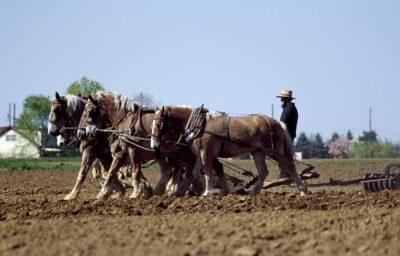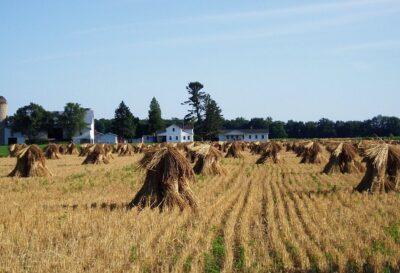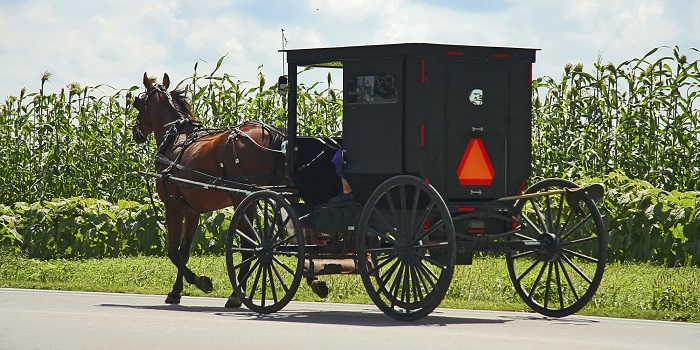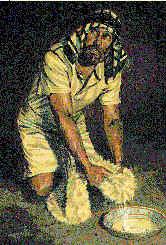Several years ago we had a week-long power outage in my region. We live in a fairly old-fashioned rural community. Nonetheless, panic still set in somewhere around hour 12 of the weather-related disaster. It was summer, a really, really hot summer. The temperatures regularly hit about 95 degrees before noon.
Friends and neighbors cleared out their refrigerators and had a community cookout at the high school. The only grocery store in the county ran out of generator power far sooner than expected. No gas station within a 25-minute drive had power. The wait at Walmart for bottled water and ice rendered the attempt fruitless.
While preparing a meal of long-term storage food on our charcoal grill, our daughter and I heard the familiar click-clack of a horse and buggy rolling by on a side street. She turned to me and said, “Do you think the Amish even noticed?”
I laughed and responded, “Probably not, at least not until an ‘English’ neighbor mentioned the ongoing power failure.” Once the news did spread to the Amish community in our county, buggies began heading to the grocery store to buy perishable items at a very steep discount. All the Amish farms and homesteads had an ice house and were fully capable of storing the bargain steaks and other “must refrigerate” items.
During the power outage, I was impressed with how our community pulled together. However, I was equally surprised that so many folks in a rural area struggled so much during the short-term disaster.
At a certain point, the editors of Off The Grid News asked if I was interested in going to visit one of the local Amish farms. They wanted me to craft a piece about homesteading skills we should all be learning, and I jumped at the opportunity. I pulled on my favorite cowboy boots and headed out in the county to enjoy some of Alma’s amazing homemade cookies. Meanwhile, I would be talking off-grid living in our modern world with her farrier husband and some local Amish community farmers.
Dependable Solar Generator Provides Back Up Power During An Outage
Sadly, we’ve lost many of the traditional homesteading skills that rural folks in my region once considered as necessary daily tasks. This includes such techniques as knowing how to grow your own food, preserve your harvest, raise and “doctor” livestock, and care for minor physical ailments. These are not only handy self-reliant skills for off-the-grid families, but they are survival attributes which could one day save your life.
My Amish friend, Ezra, said that over the course of the past year or so, more and more folks that routinely engage the services of his community have mentioned the disturbing events going on in the world. Additionally, these people have asked for tips to help them rediscover the Appalachian ways of the past as well as traditional homesteading skills.
Amish Community Homesteading Skills
1. How To Sew By Hand
Many of us suffered through mandatory middle school home economics class and likely should have paid better attention. The Amish teach simple sewing to children when they are barely more than toddlers. Learning how to make your own fabric, thread, patterns, and clothing is a money-saver for off-grid families. It’s also a necessity following a disaster. Not surprisingly, the Amish keep it simple when it comes to clothing. Learning how to sew in zippers is not necessary. The Amish secure the sturdy garments that they make with thick buttons, hook-and-eye fasteners, and Velcro.

2. How To Farm Without Machines
Amish farms most commonly grow corn, wheat, hay, soybeans, tobacco, tomatoes, barley, potatoes, green beans, and grasses for grazing livestock. In addition, they perform their farm work with horse-drawn equipment only. The wagons that they employ have durable, metal wheels and not tires made of rubber. One Amish farmer does not usually possess all the skills necessary to make wheels, shoe horses, grow crops, make furniture, etc. Nevertheless, he does network closely with other members of the community to ensure that none of the necessary items will ever be in short supply. When they need to raise a barn, the Amish frame it within a day. They strictly follow a regimen of crop rotation on an Amish farm. The replenishing of empty ground during the winter is key to developing nutrient-rich ground in the spring.
Amish Farming Task Schedule
- In April, the Amish sow oats and plant corn. They also move tomato seeds outdoors from the greenhouse in many locations.
- In May, the horses and cows are munching on well-maintained pasture. Moreover, the farmers plant the late-harvest corn.
- In June, it is hay-making time. Strawberries are also preserved and turned into a plethora of sweet delights to be enjoyed by the family and sold at roadside stands.
- July is an extremely busy month on an Amish farm. The second cutting of hay occurs, threshing must be done, honey is removed from supers, apple starts are transplanted, and sweet blackberries and raspberries are picked.
- During August, they must refill the silos before the weather turns cold and they need to complete the sowing of fall wheat.
- In October, it is cider-making and late-corn harvesting time.
3. How To Take Advantage Of Off-Grid Power
There are multiple varieties of Amish. The Old Order is far more strict when it comes to the use of any type of power. The Amish community in my area and in “Ohio Amish country” utilize both gas and solar power. Amish do know how to milk cows by hand, but are also permitted to use gas-powered milkers, barn fans, and propane appliances. If fuel suddenly became unavailable, the Amish would still be able to go about their chores and operate their businesses. Some tasks would just take a little bit longer.
Bottled gas is often used to power water heaters, stoves, and refrigerators. Gas-pressured lamps and lanterns – and even rustic lantern chandeliers — can be used to light homes, businesses, and barns. We recently visited a major supplier of propane refrigerators and stoves while in Ohio Amish country. The prices were not much higher than the modern appliances you can buy at the local big box store and offer a great off-the-grid living alternative. Some Amish communities widely use solar panels and solar generators. They have even jokingly called their solar power usage as “connecting to God’s grid.”

4. How To Identify Plants And Trees
The Amish community understands the environment which surrounds their home just as well as America’s original pioneers. They can easily rattle off details about the types of grasses which will produce specific types of crops and livestock feed. If their food ever ran out, the Amish can easily walk into the woods and quickly identify which berries and other wild-growing items are safe to eat. Know your wood! My husband embarked on this type of training with me. I felt quite proud to show off my wood identification skills when talking with members of the Amish community. Amish children are taught at a young age how to identify and understand different types of wood.
5. How To Use Hand Tools
The Amish take extremely good care of their tools. Think how closely you guarded that one special present you opened on Christmas morning as a child. Now you get the idea of how much the Amish care for their wood-hand planers, leather punches, blacksmithing equipment, horse tack, generators, and hand-powered farming implements. My Amish friends highly recommend investing in, and learning how to use hand tools. Building and repairing what you need on the homestead or during a disaster without power is essential.
Horses are considered to be equipment on an Amish farm, this does not mean that the animals are mistreated. Amish horses are extremely well-trained and rarely ever startle when exposed to new environments or traffic. Amish children learn how to ride and care for horses by the age of five. They can also saddle, harness and cart the ponies and miniature horses used during their training. When we purchased a mini for our oldest grandson, Crosley, I paid Ezra’s 5-year-old son to teach it how to cart and to “ride it out” since my grandson was a novice.
6. How To Homeschool
The Amish were perhaps the original homeschoolers. Educating your children at home, offers the opportunity to teach academic basics thoroughly and at a pace which suits your children or grandchildren. It also gives you the ability to tailor the curriculum to include hands-on learning while engaging in practical homesteading tasks at a young age. The workbooks the children in Amish communities use are very impressive. As a former educator, I can attest that the students at the first grade level, were above area public schools in reading, writing and math. The workbooks infused faith-based learning with the building blocks basics, as well as farming-specific lessons. The children, unlike many in public schools, still learn cursive writing and even had a classroom pet.
We could all pick up some pointers from the Amish community which could make our day-to-day life more rewarding, but also enhance our chances of survival if disaster strikes.










